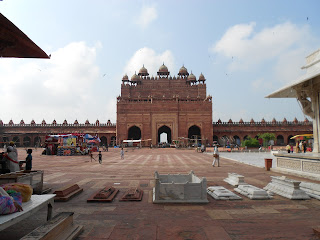This was the imperial court of Akbar at a city he built called Fatehpur Sikri. Essentially an extended palace, it had places for his various relatives and wives to live. The above picture is of the area of public court. Generally, he would listen to whatever issues these people had and then make judgements. If you were condemned, the method of death was trampling by elephant.
In fact, he loved his elephant so much that he made a tomb for it, which is above. The elephant bones sit inside there.
This is a pillar of interesting architecture. It contains architectural features of the 5 different religions that were important in India during the Mughal period in a way to promote religious unity (the religions being Islam, Buddhism, Hinduism, Christianity and Islam).
This is the library. You could still see the stone shelves inside the building.
This is where the musician would play. On the left was Akbar's personal residence.
This is decoration of the house of Akbar's Muslim wife.
This is Christian iconography from the makeup room of his Christian wife.
Here's the summer palace of his Hindu wife. Why did she get such special treatment? Well, she gave him his one and only son. This was after he consulted a guru who lived in Agra, of course, which explains the location of the fort. It also explains the giant white marble tomb nearby (not the Taj, but another one). It really is beautiful though.
Jay is just chilling on our adventure.
The tomb mentioned earlier is on the right. In the center is the largest gate in all of Asia (second largest in the world).
In fact, he loved his elephant so much that he made a tomb for it, which is above. The elephant bones sit inside there.
This is a pillar of interesting architecture. It contains architectural features of the 5 different religions that were important in India during the Mughal period in a way to promote religious unity (the religions being Islam, Buddhism, Hinduism, Christianity and Islam).
This is the library. You could still see the stone shelves inside the building.
This is where the musician would play. On the left was Akbar's personal residence.
This is decoration of the house of Akbar's Muslim wife.
This is Christian iconography from the makeup room of his Christian wife.
Here's the summer palace of his Hindu wife. Why did she get such special treatment? Well, she gave him his one and only son. This was after he consulted a guru who lived in Agra, of course, which explains the location of the fort. It also explains the giant white marble tomb nearby (not the Taj, but another one). It really is beautiful though.
Jay is just chilling on our adventure.
The tomb mentioned earlier is on the right. In the center is the largest gate in all of Asia (second largest in the world).













